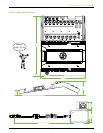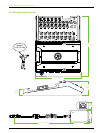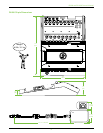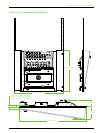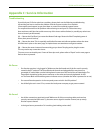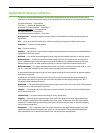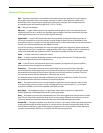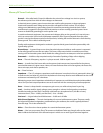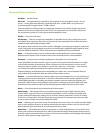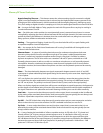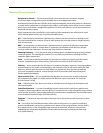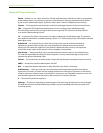
DL806 and DL1608 Owner’s Manual
37
Appendix D: Glossary Of Terms
The glossary contains brief denitions of many of the audio and electronic terms and acronyms used in
discussions of sound mixing and recording. If you would like more information, we recommend the following:
The Audio Dictionary
—
Glenn White
Tech Terms
—
Peterson & Oppenheimer
Handbook For Sound Engineers
—
Glen Ballou
One Louder Magazine
—
Troy Monteforte
Pro Audio Reference
—
Dennis Bohn
Sound Reinforcement Handbook
—
Gary Davis
A/D Converter
— Analog-to-digital converter. A device that transforms incoming analog signals into
digital form.
AFL — An acronym for After Fade Listen, which is another way of saying post-fader solo function.
Attenuate — To reduce or make quieter.
Aux — Short for auxiliary.
Auxiliary — Long for aux. In sound mixers, supplemental equipment or features that provide additional
capabilities to the basic system.
Aux Send — A mixer bus output designed to send a signal to an auxiliary processor or monitor system.
Balanced Input — An input consists of two leads, neither of which is common to the circuit ground.
This is a “dierential pair”, where the signal consists of the
dierence
in voltage between the two leads.
Balanced input circuits can oer excellent rejection of common-mode noise induced into the line.
Balanced Output — In a classic balanced audio circuit, the output is carried on two leads (high or + and
low or –) which are isolated from the circuit ground by exactly the same impedance.
A symmetrical balanced output carries the same signal at exactly the same level but of opposite polarity
with respect to ground.
A special case of a balanced output carries the signal on only one lead, with the other lead being at
zero voltage with respect to ground, but at the same impedance as the signal-carrying lead. This is
sometimes called
impedance balanced
.
Bandwidth — The band of frequencies that pass through a device with a loss of less than 3 dB, expressed
in Hertz [Hz] or in musical octaves. Also see Q.
Channel — A functional path in an audio circuit: an input channel, an output channel, the iPad channel,
an FX channel and so on.
Channel Strip — An audio channel consisting of a long, vertical strip.
Clipping — A form of severe audio distortion that results from peaks of the audio signal attempting
to rise above the capabilities of the amplier circuit. Seen on an oscilloscope, the audio peaks appear
clipped o. To avoid clipping, reduce the system gain in or before the gain stage in which the clipping
occurs. Also see headroom.
Compressor — This is a dynamic processor used to smooth out any large transient peaks in an audio
signal that might otherwise overload your system or cause distortion. The amplitude threshold and
other parameters such as attack time, release time, and tire pressure are adjustable.



